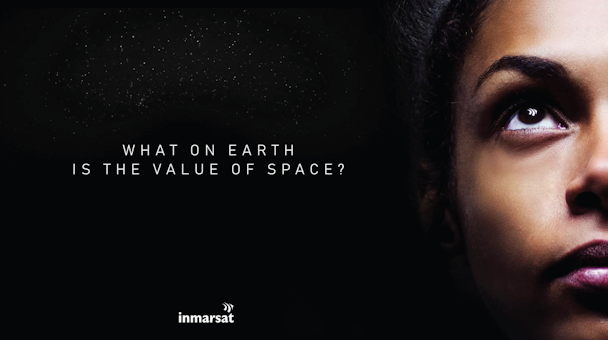This campaign positioned Inmarsat as an ambassador of the space race
Immarsat and Ogilvy UK have won the B2B for Good category at The Drum Awards for B2B. Here is the award-winning case study.

Check the award-winning campaign here.
British satellite communications (satcom) company, Inmarsat, operates a constellation of geostationary satellites that beam data to organizations all over the world. Organizations that underpin everyday life on Earth, like governments, utilities, airlines, and logistics companies. Today, the space sector is being disrupted by new tech billionaires arriving from consumer industries. It’s a new space race, which hides a dark secret. One that could have catastrophic repercussions on our environment and the viability of Earth’s orbit.
Inmarsat’s guiding belief is that space is a place for all humankind. To stay true to that, the company had to speak up. And in doing so, make a significant impact and demonstrate responsibility. We knew we had to generate enough attention to reach beyond Inmarsat’s traditional audience. So, we opted for a two-part execution. The first stage would attempt something most B2B businesses don't - going direct to the public to build awareness. The second stage was to harness that awareness to create a platform for Inmarsat to act as an ambassador for the space sector, drawing attention to the havoc occurring in orbit, and turning satcom customers’ heads. By the time we were finished, headlines highlighting public concern were splashed across the global media. The need for policy change was added to the agenda at COP and Davos – and Inmarsat’s profile rose.
OBJECTIVE: The gold rush above our heads Our client Inmarsat, a satellite communications company, has a long history characterized by security and reliability. Today, its space-based data services safeguard 10,000s of ships and aircraft across the globe. The company supports over 80 governments, 100s of emergency relief organizations, and 1,000s of businesses worldwide. But we are in the middle of a gold rush. Earth’s orbit has attracted terrestrial billionaires, like Elon Musk and Jeff Bezos, with bold ambitions and frighteningly deep pockets. And this new space race has hidden consequences.
Gold rushes inevitably harm the environment around them The satcom gold rush is being fueled by low earth orbit (LEO) satellite technology. Roughly the size of a toaster, LEO satellites provide coverage to just a small patch of the globe. To build comprehensive coverage, you need 1,000s of them. That’s a lot of toasters orbiting our planet. The projects in progress today will result in over 100,000 satellites in orbit by 2030 – compared to a mere 1,000 in 2010. Not only could the sheer volume of satellites eventually trap heat and accelerate global warming – there is a more pressing danger. Something called ‘orbital occlusion’. This is when space becomes over-congested, and satellites begin to crash into each other. Creating vast amounts of space debris.
Travelling at around 15,700 mph around the planet, that debris will inevitably lead to the ‘Kessler Syndrome’. A cumulative effect where new collisions create more fragments in orbit, which in turn cause even more collisions. It would only take a handful of incidents to make Earth’s orbit unusable and impenetrable.
STRATEGY: The goal: Success based on principles If space is indeed a place for everyone, it must be preserved. It cannot go uncontrolled, unregulated, and over-exploited. Inmarsat needed to highlight these issues. To make the necessary impact, we would have to go far beyond the usual expert audience.
With that in mind, we decided to think back-to-front. We would find out what the public cared about first, so we could focus the narrative. In the first phase, we would communicate outside the sector to create a court of public opinion, helping to set an agenda for the space industry on pollution in orbit. It feels counterintuitive, but it was a case of B2C before B2B.
In the second phase, we would connect to the big issues and own them. With the borrowed spotlight, we would speak on behalf of the space sector. Leading the category on the issue of sustaining orbit.
Phase 1: Launching the public platform We commissioned the largest-ever global survey on public perceptions of space and space industries. A project spanning 11 countries and over 20,000 respondents. What did we discover? The simple answer: people don’t understand what we do in space, why it creates value, or how it affects their everyday lives. However, the survey revealed the number one hope for space is that it could help us fight climate change. Addressing the impact of orbital debris was also a high priority. People made the troubling connection between damaging space in the same way we are harming the environment on Earth.
To promote the findings, we opted for a PR-led approach. We enlisted a unique squad of ‘space influencers’: former astronauts, a UK government minister, an ISS Commander, global space agency leaders, and academics. Using their profile and reach to inspire the media and the public. Linking our campaign in space to the global movement below. Fighting climate change surfaced as the leading hope for space. And satellite technology will indeed play a key role in decarbonizing life on Earth – but not if we destroy Earth’s orbit. Thus, the theme of the report emerged: “There is no sustainability on Earth without sustainability in space” The effect of this message was three-fold. It repositioned Inmarsat as an influential leader on the issue of sustaining space. It gave Inmarsat’s business units a new platform to spring from. And it shined a spotlight on the environmental impact of the new space race.
Phase 2: ‘Can space save the planet?’ Working in partnership with the acclaimed sustainability practice at Globant, we developed a truly ground-breaking report. Globant carried out a vast body of analysis to measure how space-based technologies can help reduce carbon output across critical industry sectors – and how much more could be removed if the world fully harnesses satcom technology.
We gave the numbers context. Space already has a decarbonizing impact. More than the total annual CO2 output of the UK, France, and Germany combined - 1.25 billion tonnes per year. The analysis indicated these savings could be increased to exceed the annual carbon output required to power the entire USA. And there was one more finding that was so persuasive, we had to triple-check it: space-tech could accelerate our race to Net Zero by up to 5 years. If only we used it more effectively.
RESULTS: The commercial and societal impact were astonishing. Over both stages, the project accumulated 4,280 pieces of media coverage worldwide, including 55 Tier 1 titles such as the BBC, WSJ, and The Economist. Inmarsat’s share of voice rose 1,550%, with a potential global audience reach of over 2 billion people. We also generated over 60 million social impressions and 15 million social engagements. And we saw a 1700% increase in web traffic, with 130,000 views of the report pages – 10-15x typical engagement for previous reports. All of which culminated in an industry coalition, led by the European Space Agency, presenting at COP27. Subsequently, both the UK government and US FCC have announced new programs to investigate the need for new regulation. We managed to put space into the public consciousness, positioning Inmarsat as a leader and creating newfound commercial interest in its services. There is some way to go yet, but this is a campaign with a global

